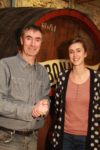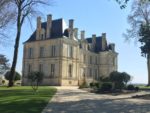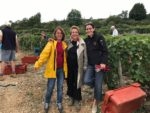Egia Tegia
The rebirth of the Basque Vineyard
I propose that we go to meet a Basque winemaker (basque country is a area of south of France): Emmanuel Poirmeur, producer of the famous EGIATEGIA (“the workshop of truths” in Basque).
 Holds a diploma in Agricultural Engineering (AgroParisTech) and oenologist, these many rich experiences in France, Italy but also in Central and South America, Emmanuel Poirmeur (pictured with the new tanks) decided in 2007 to create the first property on the French Basque Coast. Thus in 2009, he planted his own vineyards (2 hectares on the heights of Socoa) for an ultimate goal of 7 hectares.
Holds a diploma in Agricultural Engineering (AgroParisTech) and oenologist, these many rich experiences in France, Italy but also in Central and South America, Emmanuel Poirmeur (pictured with the new tanks) decided in 2007 to create the first property on the French Basque Coast. Thus in 2009, he planted his own vineyards (2 hectares on the heights of Socoa) for an ultimate goal of 7 hectares.
Fervent supporter of the creation of a new growing zone, the defender of a new form of  environmentally friendly viticulture but also men, he practice agriculture that could be described as “reasoned” or even integrated.
environmentally friendly viticulture but also men, he practice agriculture that could be described as “reasoned” or even integrated.
However that said integrated viticulture does not say archaic …. He said it is essential now to let it evolve as viticulture …. for example by using quads instead of tractors which would use less fuel but above all not to compact the soil.
Full of ideas, this urge to modernism are not limited to wine tools but also the architecture of the winery, the wine aging or the use of atypical varieties in our regions consistent with the climate and outlook changing consumption patterns, etc. …
Thus in 2007, he filed the patent for vinification and aging of wines under water. Practice widely copied since.
If you like TEDx you can see his intervention on this website.
 Why Emmanuel Poirmeur doesn’t practice a organic viticulture/farming?
Why Emmanuel Poirmeur doesn’t practice a organic viticulture/farming?
Because he wants to be free, it meets the standards but does not wish endorse “the excesses inherent in any commercial label,” regrets that the carbon is not taken into account but it is mainly because it assumes that ”the largest consumer of its wine is the winemaker, and he is aware he can, he has no reason to poison using harmful products”
The philosophy of Emmanuel Poirmeur ?
”Man and vines in perfect harmony.” Indeed according to him as “the man needed (formerly) of the vine to purify water, the vine was in need of man to be protected and conquer new spaces” man and vines has always lived together. This is also from there that he had got the idea to create a vineyard on the Basque Coast (sea front)…. one of the few areas where human presence is not accompanied by a vineyard.
- Grapes: Chardonnay (Socoa plots), Ugni Blanc, Colombard and
- Soil: clay and flint
- Vinification: champagne, wine classic in stainless steel tanks with classic malolactic. Some wines are “refermented» tank and underwater in the bay of Saint Jean de Luz, as a draw or an effervescent fermentation.
- Wine maturing process : Chardonnay, and long aging on lees in vats or casks. Colombard-Ugni Blanc: 10% concrete tanks submerged in the bay of Saint Jean de Luz and 90% aged on lees in vats. Immersion for 6 to 8 months, sur lies 18 to 24 months.
- A Basque production and a range supplemented by grapes from plots of the Pyrenees Atlantiques, Landes and Gers.
- 20,000 bottles / year
 But what is the impact of immersion? The sea is used as a source of energy. Immerse at 15 meters depth that allows putting pressure on wine allowing it to maintain the excitement. (This also brings flavors of guava)
But what is the impact of immersion? The sea is used as a source of energy. Immerse at 15 meters depth that allows putting pressure on wine allowing it to maintain the excitement. (This also brings flavors of guava)
For the anecdote, though earlier today it seems surprising that vines planted on the Basque dimension we need to remember our past. At the beginning of the century many (vines) hectares were present on this coast.
Side project:
Wishing to be the cause of the rebirth of this coastal vineyard and Basque, formerly existing. He carried out an inventory of pedo-climatic zone and produced a specification for this new wine area is exemplary in every respect. For fans of great challenge!
Another side project, Emmanuel wants to eventually develop beading wines, sparkling but also working grapes Spanish Basque (Basque country is in France and Spain).
Feel free to go and to meet Emmanuel …. you will not be disappointed!
Thanks to Emmanuel Poirmeur for his home
Choukroun Chicheportiche Jonathan
Egia Tegia
www.egiategia.com
contact@egiategia.com
Urrugne-Ciboure-Socoa 64500





